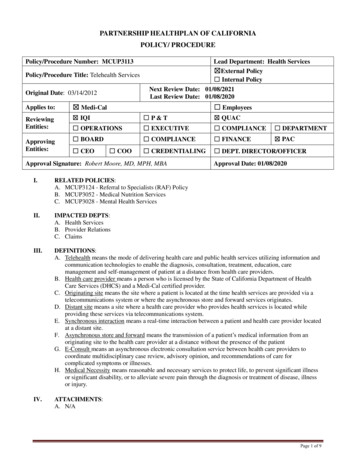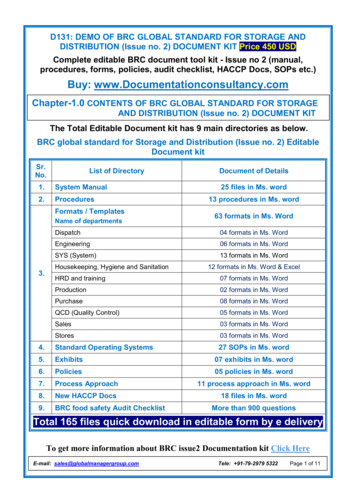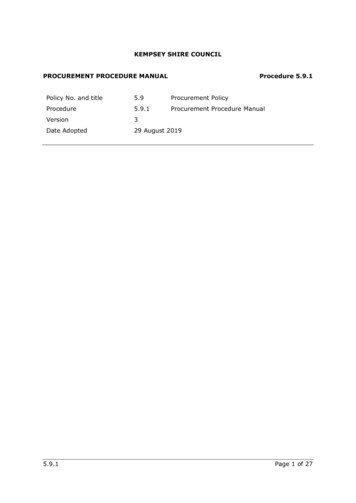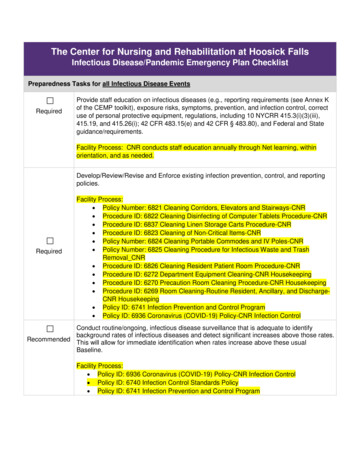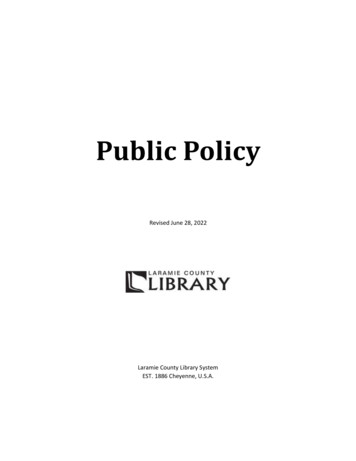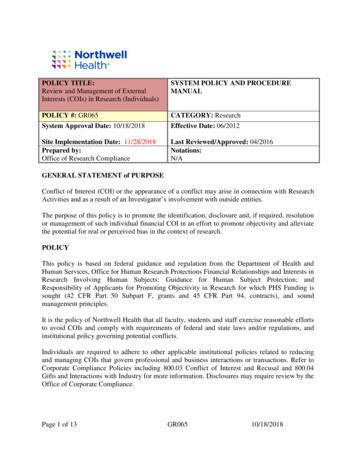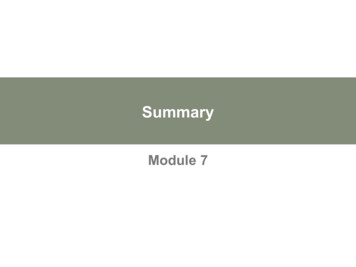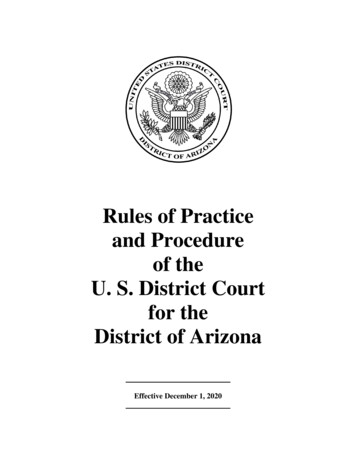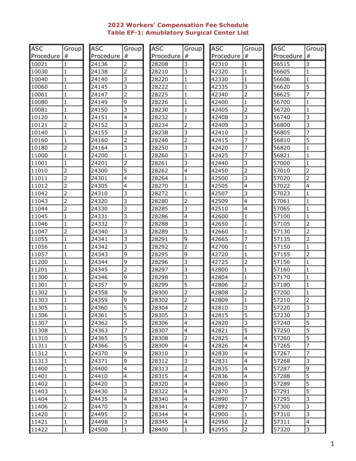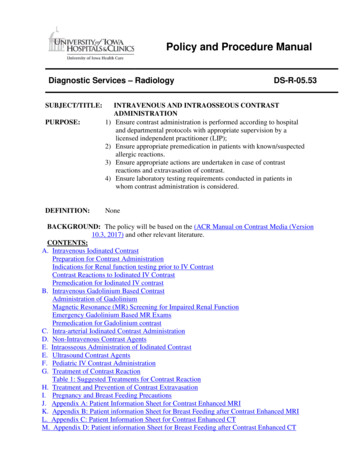
Transcription
Policy and Procedure ManualDiagnostic Services – DS-R-05.53INTRAVENOUS AND INTRAOSSEOUS CONTRASTADMINISTRATIONEnsure contrast administration is performed according to hospitaland departmental protocols with appropriate supervision by alicensed independent practitioner (LIP);Ensure appropriate premedication in patients with known/suspectedallergic reactions.Ensure appropriate actions are undertaken in case of contrastreactions and extravasation of contrast.Ensure laboratory testing requirements conducted in patients inwhom contrast administration is considered.NoneBACKGROUND: The policy will be based on the (ACR Manual on Contrast Media (Version10.3, 2017) and other relevant literature.CONTENTS:A. Intravenous Iodinated ContrastPreparation for Contrast AdministrationIndications for Renal function testing prior to IV ContrastContrast Reactions to Iodinated IV ContrastPremedication for Iodinated IV contrastB. Intravenous Gadolinium Based ContrastAdministration of GadoliniumMagnetic Resonance (MR) Screening for Impaired Renal FunctionEmergency Gadolinium Based MR ExamsPremedication for Gadolinium contrastC. Intra-arterial Iodinated Contrast AdministrationD. Non-Intravenous Contrast AgentsE. Intraosseous Administration of Iodinated ContrastE. Ultrasound Contrast AgentsF. Pediatric IV Contrast AdministrationG. Treatment of Contrast ReactionTable 1: Suggested Treatments for Contrast ReactionH. Treatment and Prevention of Contrast ExtravasationI. Pregnancy and Breast Feeding PrecautionsJ. Appendix A: Patient Information Sheet for Contrast Enhanced MRIK. Appendix B: Patient information Sheet for Breast Feeding after Contrast Enhanced MRIL. Appendix C: Patient Information Sheet for Contrast Enhanced CTM. Appendix D: Patient information Sheet for Breast Feeding after Contrast Enhanced CT
POLICY:Guidelines for administration of Intravenous contrast:1. A radiologic technologist or radiology nurse may order and/or administer intravenouscontrast under the supervision of a licensed independent practitioner (LIP) and inaccordance with procedure defined in this policy and following protocols used for contrastadministration that are based upon the type of examination ordered and define the type, doseand route of contrast.2. The supervising LIP or his/her physician designee must be available to respond promptly toan adverse event related to contrast administration.3. Protocols for administration of intravenous contrast must be reviewed by the Department ofPharmaceutical Care Drug Information Center and approved by the P&T Subcommittee andby the Contrast Committee of the Department of Radiology when the standards of care andapplication change or when the characteristics of the intravenous contrast change.4. An LIP reviews all requests for radiology procedures with intravenous contrast to determineand/or modify the appropriate protocol based on the clinical indications for the examinationand patient status. The assigned protocol is indicated in the radiology information system(RIS) or electronic medical record (EMR).5. For those procedures where a contrast protocol has been established and approved by thePharmacy and Therapeutics committee, the technologist may administer the contrast,following the established protocol, using a protocol order.6. A radiologic technologist or radiology nurse will review patient’s current medications andclinical conditions for contraindications related to intravenous contrast administration.These include allergy to contrast, use of particular medications (e.g., metformin – seebelow), and general physical condition which may impact risks for patient, such as heartfailure and asthma.7. If contraindications are identified, the supervising LIP will be contacted to determineappropriate IV contrast use.8. Type of contrast and dose information is recorded in the EMR by the nurse or technologist.9. Contrast doses that are prepared and NOT immediately administered to patient by theperson who prepared the dose must be labeled with: Drug name, strength and amount (if not apparent from container) Initials or name of the person preparing the syringe Name of patient, medical record number, date of birth and location of the patient, ifcontrast dose is prepared based upon specific patient information Oral contrast may be stored for up to 24 hours.Comprehensive Contrast PolicyPage 2 of 25
PROCEDURE:A. INTRAVENOUS IODINATED CONTRASTAll intravenous contrast utilized for CT and fluoroscopic exams at UIHC utilize iodinatedcontrast. Type of iodinated contrast include ionic vs. nonionic, high osmolar (HOCM) vs. lowosmolar (LOCM), and iso-osmolar contrast media.Preparation for Contrast Administration1. Pre-administration Checks (4 Hs)a. History; check allergies, h/o diabetes and renal disease and review labsb. Hydration; patients are asked to not consume food or carbonated drinks 2 hours prior toexam and no clear liquids 1 hour prior to exam for IV contrast. (Trauma and codestrokes protocol are exempt from these instructions)c. Have equipment and know the location of contrast reaction box and crash cart in yourwork aread. Heads up; monitor every contrast injection2. Review patients allergiesa. History of prior allergic-like reaction to contrast medium has an approximately 5-foldincreased risk of developing a future allergic-like reaction if exposed to the same classof contrast medium againb. A prior allergic-like or unknown type reaction to the same class of contrast medium isconsidered the greatest risk factor for predicting future adverse eventsc. Patients with shellfish or povidone-iodine (e.g., Betadine ) allergies are at no greaterrisk from iodinated contrast medium than are patients with other allergies. There is nocross-reactivity between different classes of contrast medium. For example, a priorreaction to gadolinium-based contrast medium does not predict a future reaction toiodinated contrast medium, or vice versa, more than any other unrelated allergy.3. Renal failure-related issues with iodinated contrastDefinitions:a. Post-contrast acute kidney injury (PC-AKI) is a general term used to describe a suddendeterioration in renal function that occurs within 48 hours following the intravascularadministration of iodinated contrast medium.b. Contrast-induced nephropathy (CIN) is a specific term used to describe a sudden deteriorationin renal function that is caused by the intravascular administration of iodinated contrastmedium; therefore, CIN is a subgroup of PC-AKIc. AKIN (Acute kidney Injury network) Criteria for the diagnosis of PC-AKI or CIN- if one ofthe following occurs within 48 hours after a nephrotoxic event (e.g., intravascular iodinatedcontrast medium exposure)1. Absolute serum creatinine increase 0.3 mg/dL ( 26.4 μmol/L).2. A percentage increase in serum creatinine 50% ( 1.5-fold above baseline).3. Urine output reduced to 0.5 mL/kg/hour for at least 6 hours.Comprehensive Contrast PolicyPage 3 of 25
Risk factors for contrast induced renal failure include:a. Pre-existing renal insufficiencyb. History of “kidney disease” as an adult, including tumor and transplantc. Diabetes mellitusd. Dehydratione. Cardiovascular disease and use of diureticsf. Age 60 yearsg. Multiple myeloma or paraproteinemia syndromes/diseasesh. Uncontrolled Hypertensioni. Hyperuricemia (gout)Medications which may increase the risk of iodinated contrast-induced renal failure:j. Metformin (oral hypoglycemic agent for diabetes): This drug is excreted by thekidneys, and may accumulate resulting in severe (even fatal) lactic acidosis.k. NSAIDs including COX-2 selective agents (e.g., ibuprofen, naproxen, ketorolac,fenoprofen, indomethacin, celecoxib, etc).l. Nephrotoxic antimicrobials (e.g., gentamicin, tobramycin, amikacin, amphotericin B,cidofovir).Indications for renal function testing prior to iodinated contrast examThe following patients must have a renal function testing within 60 days prior to IV contrastand within 24 hours for in patientsAge 60History of renal disease, including: Dialysis Kidney transplant Single kidney Renal cancer Renal surgeryHistory of hypertension requiring medical therapyHistory of diabetes mellitusMetformin or metformin-containing drug combinationsPer the ACR guidelines, there is no agreed-upon threshold of serum creatinine elevation or eGFRdeclination beyond which the risk of contrast-induced nephropathy (CIN) is considered so greatthat intravascular iodinated contrast medium should never be administered. A risk versus benefitratio is assessed in each case.Screening for renal functiona. All prior renal function testing should be also reviewed for any interval change and toreview the trend of renal function.b. If patient is in acute renal failure consult a radiologist/nephrologist prior toadministering contrast. A risk-benefit analysis for each patient, considering all therisks, possible benefits and alternatives test for obtaining the diagnosis isrecommended.Comprehensive Contrast PolicyPage 4 of 25
30 eGFR- Low risk- Per the ACR guidelines there is currently very little evidence that IViodinated contrast material is an independent risk factor for AKI in patients with eGFR 30mL/min/1.73m2. In patients with stable renal function, contrast can be administered if eGFR 30. 30eGFR OR active acute kidney injury- Higher risk- IV contrast should not be administeredunless there is a provider-to-provider conversation about the risks and benefits of IV contrast. TheIV contrast is considered diagnostically imperative, if the benefits of contrast outweigh the risk ofCIN and all other alternatives and options have been exhausted. In such a situation, the referringphysician MUST document the indication of contrast and clearly state that the benefit of contrastoutweighs the risk of CIN in the patient’s EMR. This MUST be documented in the radiologyreport as well.Measures to Prevent Nephrotoxicitya. Avoidance of Iodinated Contrast Medium- Re-evaluate the indication of IV contrastand explore other options for imaging that do not involve IV or MR contrast. This isthe preferred option for patients with AKI. Although it seems logical to use thelowest possible dose of contrast medium to obtain the necessary diagnosticinformation, robust data supporting a dose-toxicity relationship for IV iodinatedcontrast medium administration are lacking.b. Volume Expansion- before and after the IV contrast to be done by clinical teamc. At the current time there is insufficient evidence for the use of N-acetylcysteine andsodium bicarbonate, mannitol, furosemide to reduce CIN.Metformin and Metformin-Containing Medicationsa. Patients taking metformin are not at higher risk than other patients for post-contrastacute kidney injury.b. Iodinated contrast is a potential concern for furthering renal damage in patients withacute kidney injury, and in patients with severe chronic kidney disease (stage IV orstage V) Metformin does not confer an increased risk of CIN. However, patients whodevelop AKI while taking metformin may be susceptible to the development of lacticacidosis.c. Metformin and Gadolinium It is not necessary to discontinue metformin when theamount of gadolinium-based contrast material administered is in the usual dose rangeof 0.1 to 0.3 mmol per kg of body weightManagement—Patients taking metformin can be classified into one of two categories basedon the patient’s renal function (as measured by eGFR): Category I - In patients with no evidence of AKI and with eGFR 30 mL / min/1.73m2,there is no need to discontinue metformin either prior to or following contrast. No need toreassess the patient’s renal function following the test or procedure. Category II - In patients taking metformin with acute kidney injury or severe chronickidney disease (stage IV or stage V; i.e., eGFR 30), or are undergoing arterial catheterstudies that might result in emboli (atheromatous or other) to the renal arteries, metforminshould be temporarily discontinued at the time of or prior to the procedure, and withheldComprehensive Contrast PolicyPage 5 of 25
for 48 hours post procedure and restarted only after renal function has been re-evaluatedand found to be normal.Pre procedure considerations in special situations:Pheochromocytoma: There is no evidence that IV administration of modern iodinated orgadolinium-based contrast medium increases the risk of hypertensive crisis in patients withpheochromocytoma.Sickle-Cell Trait/Disease: Patients with Sickle-Cell may receive contrast medium.Myasthenia Gravis: There is a questionable relationship between IV iodinated contrastmedium and exacerbations of myasthenic symptoms in patients with myasthenia gravis. Atthis time it is controversial whether iodinated contrast medium should be considered a relativecontraindication in patients with myasthenia gravis. Prior to administration, refer to risk vs.benefits and contact a radiologist if you have questions. Hyperthyroidism: There is no evidence that IV administration of modern iodinated contrastmedium should be avoided in patients with acute thyroid storm In For patients consideringradioactive iodine therapy or in patients undergoing radioactive iodine imaging of the thyroidgland, administration of iodinated contrast medium can interfere with uptake of the treatmentand diagnostic dose. If iodinated contrast medium was administered, a washout period issuggested to minimize this interaction. The washout period is ideally 3-4 weeks for patientswith hyperthyroidism, and 6 weeks for patients with hypothyroidism. PPatients on DialysisPatients on dialysis can receive IV contrast and early post-procedural dialysis is NOTroutinely required in every case. The Nephrology Service should be consulted for thesecases. The fact that a patient is on dialysis should NOT be regarded as automaticallyallowing the administration IV contrast.Maximum Permissible Dose of ContrastCurrently, there is no clinical maximum permissible dose of contrast listed. Our recommendedmaximum general volume of contrast over of 300 CC in a 24 hour period should be avoided.Call a radiologist if it is determined there is a need to surpass this threshold. Separatingmultiple doses of contrast by 24 hour interval is suggested. Due regard should be given to theneed of IV contrast for an optimal study, rather rigid adherence to a numeric value.CONTRAST REACTIONS TO IODINATED IV CONTRASTReactions to iodinated IV contrast occur in 1-3% of nonionic low-osmolar contrast injections.These range from mild urticaria (hives) to severe and life-threatening events. The severe lifethreatening reactions are relatively rare. Although overall adverse reactions are decreasedfollowing steroid premedication, the incidence of severe life-threatening adverse events hasnot been affected. Therefore, administration of IV contrast in patients with previous severereactions should be done only in exceptional circumstances with full agreement by the patient,attending physician(s) and radiologist.Comprehensive Contrast PolicyPage 6 of 25
1. Premedicationa. Premedication prior to intravenous iodinated and gadolinium-based contrast injectionsare indicated with history of prior moderate to severe reaction only, examples:increasing hives, facial swelling, itching, acute rash, wheezing, bronchospasm, stridor,laryngeal edema and anaphylaxisb. Premedication is not needed for history of asthma, reactions to other substances(regardless of number or severity, including shellfish and betadine) and physiologicreaction to iodinated contrast material such as a vasovagal reaction, nausea andvomiting.c. The risk of breakthrough reaction still exists in patients with severe reactiond. Corticosteroids are critical component of the premedication regimen and should begiven at least 6 hours prior to the contrast.e. After diphenhydramine (Benadryl) patient must have a driver to and from theappointment, due to the possibility of drowsiness from the medication.Adult Patienta.Standard oral premedication regimen: Prednisone—50 mg PO, 13, 7 and 1 hour prior to the procedureOR Methylprednisolone— 32 mg PO 12 hours and 2 hours prior AND Diphenhydramine—50 mg PO 1 hour prior to the procedureNote: Doses may be distributed unevenly to allow a patient to get a reasonablenight’s sleep the evening prior to the CT; however, the first dose should be takenmore than 12 hours before and a second dose within the last 6 hours of thescheduled exam.b.Alternate IV protocol if a patient cannot take oral medications: Hydrocortisone—200 mg IV, 13, 7 and 1 hour prior to the procedureDiphenhydramine—50 mg IM or IV, 1 hour prior to the procedurec.Accelerated IV premedication protocol, when there are no alternatives: Hydrocortisone—200 mgORMethylprednisolone—40 mg IV, 4 hours and 1 hour prior to the procedureANDDiphenhydramine—50 mg PO/IM/IV, 1 hour prior to the procedure (ifblood pressure permits)Comprehensive Contrast PolicyPage 7 of 25
Pediatric Patienta.Standard oral premedication regimen: Prednisone—0.5-0.7 mg/kg PO, 13, 7 and 1 hour prior to the procedure (50mg maximum dose)Diphenhydramine—1.25 mg/kg PO 1 hour prior to the procedure (50 mgmaximum dose)2. Non-emergent contrast administration in premedicated patientsa. Patients who are premedicated for prior reactions, being imaged for non-emergentindications should not be scanned after hours. The pre medication may be scheduled insuch a way that the patient is scanned the first thing next morning, when adequateresources are available to handle any breakthrough reactions.b. If clinical situation warrants emergent scanning after hours in a patient who has receivedthe premedication for prior contrast allergy: The afterhours scanning of the premedicated patient should be approved by theradiology faculty member during the day. The on-call radiology resident must be informed by the day team about thescanning of premedicated patient. The technologist will page the on-call radiology resident before administeringthe contrast. The on-call radiology resident must request a LIP from the clinical team to bepresent with the patient at the time of contrast administration and for theduration of the entire scan. They must accompany the patient back to the floorcover for any delayed reaction.c. On call and on weekends, any case with history of contrast allergy should go through theon-call radiology resident to determine alternative method of scanning vs. need forpremedication.d. For CT studies, imaging of premedicated patients after hours will be done in the ETCscanner where the radiology resident is readily available.3. Emergent contrast administration in life-threatening situationsIn cases of life-threatening emergency requiring administration of IV contrast and whereclinical team cannot wait to complete the accelerated IV premedication protocol requiringadministration of steroids 4 hours and 1 hour prior to the procedure AND the alternative test isnot acceptable:a. The clinical team must add a note in the EMR of the patient prior to the contrastadministration which clearly states the following: Indication of the urgent study. Reason why the alternative exam (as offered by the radiologist) is notacceptable. Ensure that sufficient staff capable of handling the severe contrast reaction;including intubation and administration of life support drugs is available duringand after the procedure.Comprehensive Contrast PolicyPage 8 of 25
b. You may still consider giving hydrocortisone 200 mg IV and diphenhydramine(Benadryl ) 50 mg IV stat prior to contrast administration and 4 hours later to coverdelayed reaction, Premedication regimens less than 4-5 hours in duration (oral or IV) have notbeen shown to be effective.B. INTRAVENOUS GADOLINIUM BASED CONTRAST AGENTSSince their introduction in 1988, gadolinium-based contrast agents (GBCA) for MRI have largelyenjoyed an excellent safety profile. However, in 2006 reports first appeared linking GBCA with arare but serious disease called nephrogenic systemic fibrosis (NSF) that primarily affects the skinand subcutaneous tissues and occasionally the muscles and internal organs. NSF has no knowncure. All affected patients had severe or end-stage chronic kidney disease (CKD 4 or 5), acutekidney injury (AKI), or were on renal dialysis. The exact risk of developing NSF after exposureto intravenous GBCA is unknown, but a growing body of evidence indicates that the riskdepends strongly on the molecular structure of the GBCA. The FDA, American College ofRadiology (ACR) and European Medicines Agency have developed classification systems toreflect the differential NSF risk of the various GBCA. In the ACR system, which has threegroups (I, II and III), GBCA in group 1 carry the highest NSF risk, perhaps as great as 1-7% perdose. In response to these data, the FDA banned the use of group I agents in patients withimpaired renal function in 2010. At UIHC, all group I agents have been removed from theformulary. Group II agents carry the smallest NSF risk. The vast majority of MRI examsperformed at UIHC utilize a group II agent, either Gadavist (gadobutrol) or Dotarem (gadoterate meglumine). Group III agents have insufficient data to determine their NSF risk.The only group III agent currently available in the USA is Eovist (gadoxetate disodium). Thisagent is used selectively at UIHC for MRI exams of the liver and bile ducts.In 2010 the FDA issued a Safety Announcement called a “black box” warning that requirespatients to be screened for “acute kidney injury and other conditions that may reduce renalfunction” prior to receiving any GBCA. However, recent data have suggested that the FDAscreening recommendations for group II agents are overly cautious. The ACR Manual onContrast Media (2018, Version 10.3) directly addresses the latest thinking about screeningrecommendations: “Based on the most recent scientific and clinical evidence, the ACRCommittee on Drugs and Contrast Media considers the risk of NSF among patients exposed tostandard or lower than standard doses of group II GBCAs is sufficiently low or possiblynonexistent such that assessment of renal function with a questionnaire or laboratory testing isoptional prior to intravenous administration.” The latest ACR position informs our decision toupdate the UIHC contrast policy.1. Screening for impaired renal functionOutpatients/ED or inpatients scheduled to receive Gadavist or Dotarem: No further screening is required.Adult Outpatients/ED scheduled to receive Eovista. must be screened for conditions that increase the risk of impaired renal function (seebelow): Diabetes Mellitus (insulin-dependent, oral hypoglycemic or diet-controlled)History of renal disease (dialysis – any form, renal insufficiency or failure, solitarykidney, renal transplant, renal tumor or renal surgery)Comprehensive Contrast PolicyPage 9 of 25
Other conditions as deemed appropriate by the responsible radiologist.If the patient answers YES to any of the above risk factors (except dialysis or AKI), aneGFR must be checked within an acceptable time window, as described below. A documented eGFR 45 obtained 6 weeks prior to GBCA administrationsatisfies the screening.If no prior eGFR is available or if the prior eGFR was obtained 6 weeks ago, aneGFR should be checked 48 hours prior to GBCA.If the prior eGFR was 45 (regardless of risk factors), an eGFR should be checked 48 hours prior to GBCA.If the rechecked eGFR is 30, see subheading “4B” below.b. Adult Inpatients scheduled to receive Eovist must have a documented eGFR 30obtained 48 hours prior to GBCA administration. If that eGFR is 30 or if the patienthas acute renal failure (AKI) or is on renal dialysis, see subheading “4B” below.c. Pediatric patients scheduled to receive Eovist . The eGFR screening policies for adultoutpatients/ED and inpatients (b and c, above) need not be strictly followed in neonatesand infants due to the high prevalence of low eGFR values in this population. Thedecision to use Eovist should be based primarily on clinical necessity.d. Emergency MR Exams with IV Eovist contrastThis section pertains to the following unusual circumstances: Request is for an emergency Abdominal MRI exam with Eovist. Patient would ordinarily require eGFR screening for renal insufficiency No current serum eGFR is available The referring physician believes that a delay in performing the MR study due toobtaining a serum eGFR would compromise patient care. At the discretion of the responsible radiologist, the patient may undergo an MRexam with Eovist without a current eGFR. The ordering physician must add a note in the medical record of the patient priorto the contrast administration which clearly states the benefit outweighs the risk.2. AKI. Recognition of AKI requires a high clinical suspicion. Helpful clinical and laboratoryfindings include: rise in serum creatinine ( 0.3 mg/dl over 48 hours or 1.5 times increase abovebaseline over 7 days) risk factors such as recent surgery, severe infection, severe trauma, andnephrotoxic drugs Please note that eGFR is not a reliable indicator of AKI.3. Renal Dialysis: Patients currently on dialysis (hemodialysis, peritoneal dialysis or continuousdialysis) do not need to have their eGFR checked. For patients currently on hemodialysis, dialysis should be performed as soon asreasonably possible, but no later than 24 hours after an MRI exam with IV GBCA.However, if the MRI is urgent and delaying the exam due to dialysis wouldComprehensive Contrast PolicyPage 10 of 25
compromise patient care, the MRI exam may be performed irrespective of thedialysis schedule.Please be aware that hemodialysis has NOT been proven to decrease NSF risk afterGBCA exposure.The ordering provider should indicate if the patient is on continuous dialysis(CVVD, etc.) as these patients are at increased risk for NSF, but may appear tohave an eGFR 30. 4. Administration of GBCA in patients with impaired renal functiona. Gadavist and Dotarem: In patients with impaired renal function (CKD 4 or 5, AKI, ordialysis) the risk of developing NSF from a group II GBCA is minimal. Thus, thedecision to perform an MR exam with Gadavist or Dotarem in an adult or pediatricpatient should not hinge on renal function. Instead, the responsible radiologist shouldconsider issues that would apply to any patient undergoing advanced diagnosticimaging, mainly: Is the MR exam clinically appropriate and will it impact patient care?Is intravenous contrast necessary to obtain the desired diagnostic information?Can similar diagnostic information be obtained more safely and at lower costwith another imaging modality or diagnostic test?b. Eovist: There is insufficient data to determine the NSF risk of Eovist. Prior toadministering this GBCA to a patient with impaired renal function (CKD 4 or 5, AKI,or dialysis), the responsible radiologist should determine if the marginal benefit ofEovist outweighs its potentially higher NSF risk. In many (but not all) clinical scenariosGadavist or Dotarem can provide similar diagnostic information. If the responsibleradiologist and ordering physician agree that Eovist is appropriate and clinicallyindicated, the following steps must be performed prior to contrast administration: The ordering physician must place a note in the patient’s EMR prior to contrastadministration that clearly states the benefits of Eovist outweigh the risks.The patient will be given copy of Information Sheet for Patients Scheduled forEovist-Enhanced MRI. The responsible radiologist will explain the risks andbenefits of the proposed MRI exam and the patient will have an opportunity todiscuss any concerns. If the patient agrees to proceed with the MRI exam, theradiologist will obtain verbal informed consent.5. Administration of GBCA for various MR examsa. Most contrast-enhanced MRI exams will be performed with single dose IV Gadavist gadobutrol) 0.1 mmol/kg (0.1 ml/kg) body weight. If a patient has had previous contrastreactions or nausea/vomiting to Gadavist (gadobutrol), use Dotarem (gadoteratemeglumine) at 0.1 mmol/kg (0.2 ml/kg).b. Some abdominal MRI exams of the liver and biliary tree may be performed with IVEovist (gadoxetate disodium) at a dose of 0.2 ml/kg.c. MR Enterography exams will be performed IV Gadavist (gadobutrol) at 0.15 ml/kg.If patient has a history of contrast reactions or nausea/vomiting to Gadavist (gadobutrol), use Dotarem (gadoterate meglumine) at 0.3 ml/kg.d. Contrast-enhanced MRA exams will be performed with IV Gadavist (gadobutrol) asfollows:Comprehensive Contrast PolicyPage 11 of 25
e.f.g.h. Single station MRA –10 ml Gadavist (gadobutrol). Two or three station MRA – 15 ml Gadavist (gadobutrol) diluted with 25 ml salineto 40 ml total volume.Contrast-enhanced MR venography of the pelvis and lower extremities will be performedwith 30 ml IV Dotarem (gadoterate meglumine) diluted with 30 ml saline to a totalvolume of 60 ml.Contrast-enhanced MRA of the pelvis and lower abdomen for Pelvic CongestionSyndrome will be performed with 10 ml Gadavist (gadobutrol).Contrast-enhanced cardiac MRI exams for myocardial viability will be performed withIV Gadavist (gadobutrol) at 0.2 ml/kg or Dotarem (gadoterate meglumine) at 0.4ml/kg.Pediatric Patients: Contrast-enhanced MRI exams will be performed with single dose IV Gadavist (gadobutrol): 0.1 ml/kg body weight. MRA Neck, Brain, and MRV Brain will be performed with single dose IVDotarem (gadoterate meglumine): 0.2 ml/kg body weight for patients less than 50kg (110 lbs). All other MRA’s below neck will be performed with double dose IV Dotarem (gadoterate meglumine) for patients less than 50 kg (110 lbs): 0.4 ml/kg bodyweight in all patients. Contrast-enhanced MRA exams for patients over 50 kg (110 lbs) will be performedwith IV Gadavist (gadobutrol) as follows:1. Single station MRA - 10 ml Gadavist (gadobutrol)2. Two or three station MRA – 15 ml Gadavist (gadobutrol) diluted to 40ml
AKIN (Acute kidney Injury network) Criteria for the diagnosis of PC -AKI or CIN if one of the following occurs within 48 hours after a nephrotoxic event (e.g., intravascular iodinated contrast medium exposure) 1. Absolute serum creatinine increase 0.3 mg/dL ( 26.4 μmol/L). 2.
